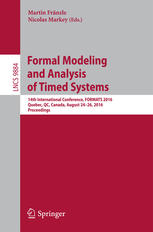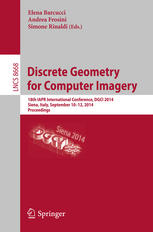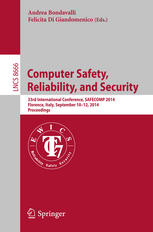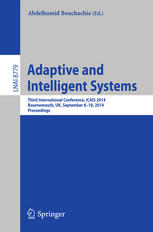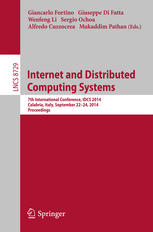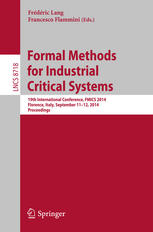Formal Modeling and Analysis of Timed Systems 1st Edition by Axel Legay, Marius Bozga ISBN 3319105116 9783319105116
$50.00 Original price was: $50.00.$25.00Current price is: $25.00.
Formal Modeling and Analysis of Timed Systems 1st Edition by Axel Legay, Marius Bozga – Ebook PDF Instant Download/Delivery: 3319105116, 978-3319105116
Full download Formal Modeling and Analysis of Timed Systems 1st Edition after payment
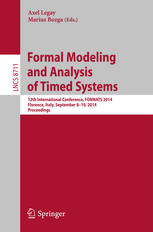
Product details:
ISBN 10: 3319105116
ISBN 13: 978-3319105116
Author: Axel Legay, Marius Bozga
This book constitutes the refereed proceedings of the 12th International Conference on Formal Modeling and Analysis of Timed Systems, FORMATS 2014, held in Florence, Italy, in September 2014.
The 17 revised full papers presented were carefully reviewed and selected from 36 submissions. The papers cover topics of foundations and semantics; comparison between different models, such as timed automata, timed Petri nets, hybrid automata, timed process algebra, max-plus algebra, probabilistic models; methods and tools for analyzing timed systems and resolving temporal constraints; applications in real-time software, hardware circuits, and problems of scheduling in manufacturing and telecommunication.
Formal Modeling and Analysis of Timed Systems 1st Table of contents:
1. Bitcoin Modeling and Security Protocols
- 1.1 A Short Description of Bitcoin
- 2. Modeling the Bitcoin
- 2.1 The Keys, the Secret Strings, and the Signatures
- 2.2 The Transactions
- 2.3 The Parties
- 2.4 The Adversary
- 2.5 The Block Chain and the Notion of Time
- 3. Modeling the Bitcoin-Based Timed Commitment Scheme from [8]
- 3.1 The Results of the Verification
- 3.2 The NewSCS Protocol from [8]
- References
2. Data-Driven Statistical Learning of Temporal Logic Properties
- 1. Introduction
- 2. Problem Statement and Methodology
- 2.1 Statistical Modelling of Data: Learning and Model Selection
- 2.2 Learning Properties
- 3. Results
- 3.1 Logical Characterisation of a Biological Oscillator
- 3.2 Logical Discrimination of Cardiac Arrhythmias
- 4. Related Work
- 5. Conclusions
- References
3. Execution Time Analysis Using Difference-Bound Matrices
- 1. Introduction
- 2. Preliminaries
- 2.1 Timed Automata
- 2.2 The Zone Approach
- 2.3 The Difference Bound Matrices
- 3. Zone-Based Algorithms For Calculating BCET and WCET
- 3.1 The Zone-Based Algorithms
- 4. Implementation
- 5. Case Studies
- 6. Conclusion
- References
4. Delay-Dependent Partial Order Reduction for Time Petri Nets
- 1. Introduction
- 2. Time Petri Nets
- 2.1 Definition and Semantics
- 2.2 Contracted State Class Graph
- 3. Partial Order Reduction Based on POSETs
- 3.1 Partial Order Successors and Reduced State Class Graphs
- 4. RSCG Preserving Non-equivalent Sequences of N
- 4.1 Delay Lower Bound Matrix of N
- 4.2 Computing a Partial Order Generator G
- 4.3 Does G Preserve the Non-equivalent Firing Sequences of N?
- 5. Experimental Results
- 6. Conclusion
- References
5. On MITL and Alternating Timed Automata Over Infinite Words
- 1. Introduction
- 2. Preliminaries
- 3. The Intervals Semantics for OCATA on Infinite Words
- 4. TOCATA: A Class of OCATA for MITL
- 5. MITL Model-Checking and Satisfiability with TOCATA
- 6. Experimental Results
- References
6. Time Petri Nets with Dynamic Firing Dates
- 1. Introduction
- 2. Time Petri Nets and Fickle Transitions
- 2.1 A Semantics for Time Petri Nets Based on Firing Functions
- 2.2 Interesting Classes of DTPN
- 2.3 Interpretation of the Quantized State System Model
- 3. A State Class Abstraction for Dynamic TPN
- 4. Two Applications for Dynamic TPN
- 4.1 Scheduling Preemptive Tasks
- 4.2 Verification of Linear Hybrid Systems
- 5. Conclusion and Related Work
- References
7. Timed Game Strategies: Verification and Performance Evaluation
- 1. Introduction
- 2. Timed Game
- 2.1 Timed Game Automata
- 2.2 A Running Example
- 3. Stochastic Priced Timed Automata
- 3.1 Priced Timed Automata
- 3.2 Stochastic Semantics
- 4. Translating Strategies to Timed Automata
- 4.1 The Method
- 4.2 The Running Example
- 5. MC and SMC under Strategies
- 5.1 Extended Stochastic Semantics
- 5.2 Implementation
- 5.3 The Running Example
- 6. Experimental Results
- 6.1 Case Study 1: Jobshop
- 6.2 Case Study 2: Train-Gate
- 7. Future Work
- References
8. The Power of Proofs: New Algorithms for Timed Automata Model Checking
- 1. Introduction
- 2. Background
- 2.1 Timed Automata
- 2.2 Timed Logic Lrel ν,μ and Modal Equation Systems (MES)
- 3. Checking Lrel,af ν,μ Properties: A Proof-Based Approach
- 3.1 Proof Rules for Laf ν,μ Over Timed Automata
- 3.2 New Proof Rules for the Relativized Operators of Lrel,af ν,μ
- 4. Optimizing Performance via Derived Proof Rules
- 5. Implementation Details
- 5.1 Addressing Non-convexity: Zone Unions
- 5.2 Addressing Performance: Simpler PES Formulas
- 5.3 Placeholder Implementation Complexities
- 6. Performance Evaluation
- 6.1 Methods: Evaluation Design
- 6.2 Data and Results
- 6.3 Analysis and Discussion
- 7. Conclusion
- References
9. Anonymized Reachability of Hybrid Automata Networks
- 1. Introduction
- 2. Hybrid Automata Network Syntax and Semantics
- 2.1 Semantics of Hybrid Automata Networks
- 3. Anonymized State-Space Representation
- 4. Anonymized Reachability of Hybrid Automata Networks
- 5. Experimental Results
- 6. Summary
- References
10. Combined Global and Local Search for Falsification of Hybrid Systems
- 1. Introduction
- 2. Problem Formulation
- 3. Algorithm
- 4. Algorithmic Details
- 4.1 Computation of the Path of Minimal Cost
- 4.2 Heuristics
- 4.3 Paths of Minimal Cost
- 5. Local Optimization
- 6. Termination Proof
- 7. Computational Experiments
- 8. Related Work
- 9. Conclusion
- References
11. Weak Singular Hybrid Automata
- 1. Introduction
- 2. Preliminaries
- 2.1 Singular Hybrid Automata
- 2.2 Reachability, Schedulability, and Model-Checking
- 3. Weak Singular Hybrid Automata
- 3.1 Constant-Rate Multi-mode Systems
- 3.2 Syntax and Semantics
- 4. Undecidable Variants of WSHA
- 5. Conclusion
- References
12. Non-convex Invariants and Urgency Conditions on Linear Hybrid Automata
- 1. Introduction
- 2. Linear Hybrid Automata with Non-convex Invariants
- 2.1 Definition and Semantics
- 2.2 Computing the Continuous Post Operator with Nonconvex Invariants
- 2.3 Related Work
- 3. Linear Hybrid Automata with Urgency
- 3.1 Definition and Semantics
- 3.2 Reachability
- 3.3 Computing the Urgent Continuous Post Operator
- 3.4 Related Work
- 4. Example: Batch Reactor
- 5. Conclusions
- References
13. Time-Bounded Reachability for Initialized Hybrid Automata
- 1. Introduction
- 2. Preliminaries
- 2.1 Sets and Functions Notations
- 2.2 Transition Systems and Hybrid Automata
- 3. Time-Bounded Reachability
- 3.1 Bounding the Execution Length in Logarithmic Timed Automata
- 3.2 Algorithm for Time-Bounded Reachability
- 4. Time-Bounded Reachability is PSPACE-Hard in Initialized Linear Inclusion Automata
- 5. Conclusion
- References
14. Virtual Integration of Real-Time Systems
- 1. Introduction and Related Work
- 2. Real-Time Interfaces
- 3. Contracts and Virtual Integration
- 4. Compositional Virtual Integration
- 5. Resource Segregation
- 6. Case Study
- 7. Conclusion
- References
15. Timed Pattern Matching
- 1. Introduction
- 2. Timed Regular Expressions over Signals
- 3. Match-Sets and Zones
- 4. Computation
- 4.1 Algorithms and Implementation
- 4.2 A Bound on the Number of Iterations
- 5. Experimentation
- 6. Future Work
- References
16. Interval Abstraction Refinement for Model Checking of Timed-Arc Petri Nets
- 1. Introduction
- 2. Definitions
- 3. Interval Abstractions
- 3.1 Approximation Correctness for Reachability
- 3.2 Approximation Correctness for Liveness
- 4. Trace Validation
- 5. Evaluation
- 6. Conclusion
People also search for Formal Modeling and Analysis of Timed Systems 1st:
formal modeling and analysis of distributed systems
what is formal modeling
computational modeling formal analysis and tools for systems biology
international conference on formal modeling and analysis of timed systems
simulation and modeling analysis
Tags:
Axel Legay,Marius Bozga,Formal,Modeling,Analysis,Timed,Systems 1st
You may also like…
Computers - Computer Science
Computers - Programming
Computers - Computer Science
Computers - Computer Science
Computers - Networking
Computers - Computer Science
Computers - Computer Science




